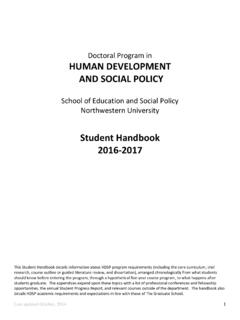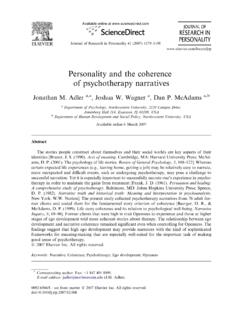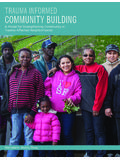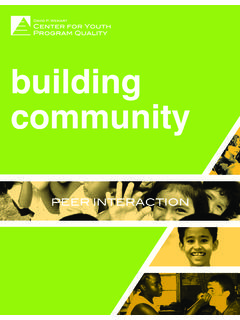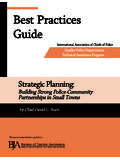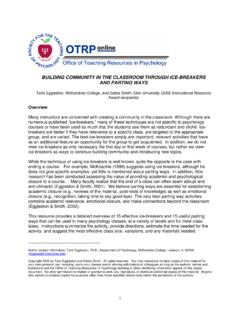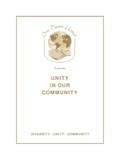Transcription of DISCOVERING COMMUNITY POWER
1 DISCOVERING COMMUNITY POWER : A GUIDE TO MOBILIZING LOCAL ASSETS AND YOUR. ORGANIZATION'S CAPACITY. A COMMUNITY - building Workbook from the Asset-Based COMMUNITY Development Institute School of Education and Social Policy Northwestern University 2120 Campus Drive Evanston, IL 60208-4100. John P. Kretzmann and John L. McKnight, Co-Directors By John P. Kretzmann and John L. McKnight, Co-Directors with Sarah Dobrowolski, Project Coordinator and Deborah Puntenney, 2005 by the ABCD Institute Acknowledgments Acknowledgments Funded by the Kellogg Foundation, the Asset-Based COMMUNITY Development (ABCD) Institute developed DISCOVERING COMMUNITY POWER : A. Guide to Mobilizing Local Assets and Your Organization's Capacity.. Please note: although this document is copyrighted, permission for use will be granted upon notification of intended use to the ABCD Institute. Please email the ABCD Institute with the name of your group or organization and a brief description of how you plan to use the Guide.
2 This information will help us with future research and evaluation. The Guide is available to download freely on the Kellogg Foundation's website: and the ABCD Institute's website: A COMMUNITY building Workbook 2005 Asset-Based COMMUNITY Development Institute Introduction 1. Introduction Strengthening Your Proposal And Your Organization . By Connecting With COMMUNITY Assets The Kellogg Foundation is very interested in proposals that both improve the COMMUNITY and strengthen the applicant organization. Our experience indicates that proposals which connect with and engage a wide range of COMMUNITY resources are more effective than those which involve only the staff of the lead organization. We are also convinced that non-profit organizations are much more powerful COMMUNITY actors when they are not exclusively focused on needs, problems, and deficiencies but are effectively connected to the resources, or assets, of the local COMMUNITY . This document will help any organization: 1. Strengthen its own organization by enhancing connections with the COMMUNITY 's assets.
3 2. Strengthen the COMMUNITY by investing in the COMMUNITY 's assets. 3. Strengthen current and future COMMUNITY based projects, activities, and proposals. The following pages are divided into three sections to help applicants connect with COMMUNITY assets. Section One How to assess and strengthen your proposal's relationships with and utilization of COMMUNITY assets; and Section Two How to identify and connect your non-profit organization's assets to this project. Section Three Tools which may be helpful in connecting both projects and organizations to COMMUNITY assets. Section Four Information about the ABCD Institute. In Section One of this manual, we will introduce a series of questions designed to guide your reflections about a proposal's relationships to five categories of COMMUNITY assets. These include: 1. Local residents their skills, experiences, passions, capacities and willingness to contribute to the project. Special attention is paid to residents who are sometimes marginalized.
4 A COMMUNITY building Workbook 2005 Asset-Based COMMUNITY Development Institute 2 Introduction 2. Local voluntary associations, clubs, and networks , all of the athletic, cultural, social, faith-based, etc. groups powered by volunteer members . which might contribute to the project. 3. Local institutions- public institutions such as schools, libraries, parks, police stations, etc., along with local businesses and non-profits which might contribute to the project. 4. Physical assets the land, the buildings, the infrastructure, transportation, etc. which might contribute to the project. 5. Economic assets what people produce and consume, businesses, informal economic exchanges, barter relationships, etc. In Section Two, we will provide questions to guide you in asking about your own organization's wide range of assets, and their relationship to the proposed project. In Section Three, you will find additional tools and illustrations to help you connect your proposal and your organization with COMMUNITY assets.
5 In Section Four, you will find information about the ABCD Institute. Throughout this document you will see several symbols repeated: When you see this symbol, what follows is a really important idea. * When you see this symbol, what follows is the location of the page on which you can find additional information. A COMMUNITY building Workbook 2005 Asset-Based COMMUNITY Development Institute Introduction 3. Producing Strong COMMUNITY -Based Projects This document is based on the following simple equation: Your COMMUNITY 's Assets Connected To (+). Your Organization's Assets Produces (=). Strong COMMUNITY -Based Projects A COMMUNITY building Workbook 2005 Asset-Based COMMUNITY Development Institute Section I: 4. An Asset-Based Framework to Explore Your Project Section I. Index How to assess and strengthen your proposal's relationships with and utilization of COMMUNITY assets. Page 5: Relationships with Local Residents Page 6: Relationships with Residents Who are Often Marginalized Pages 7-8: Relationships with Associations Pages 9-10: Relationships with Institutions Page 11: Relationships with Physical Space Pages 12-13: Relationships with the Local Economy Page 14: A Bridge to Resources Outside the Local COMMUNITY Page 15: A Sample COMMUNITY Asset Map Page 16: Your COMMUNITY Asset Map Page 17: Connecting Your COMMUNITY 's Assets to this Project A COMMUNITY building Workbook 2005 Asset-Based COMMUNITY Development Institute 5 Section I: An Asset-Based Framework to Explore Your Project Relationships with Local Residents: Sustainable projects are often powerfully related to the involvement of residents.
6 Example: In many communities, resident skills and interests are uncovered through the use of skills surveys or capacity inventories. These communities discover that everyone has gifts to contribute which can strengthen the COMMUNITY . * For sample capacity inventories, see Section 3, pages 23-24. Below are questions which gauge your project's interaction with local residents. Our project mobilizes the skills and capacities of local residents. Not at All Some A Great Deal 1 2 3 4 5. Describe: Our project works to enhance the skills and capacities of local residents. Not at All Some A Great Deal 1 2 3 4 5. Describe: Local residents help define our project objectives. Not at All Some A Great Deal 1 2 3 4 5. Describe: Local residents will act as: * For definitions of these roles, see Section 3, Page 25. Recipients Information Sources Participants In Control Describe: A COMMUNITY building Workbook 2005 Asset-Based COMMUNITY Development Institute Section I: 6. An Asset-Based Framework to Explore Your Project Relationships with Residents Who are Often Marginalized: Communities are strengthened when organizations encourage and support diversity.
7 Often times, groups of people, like welfare recipients, elders, youth and minorities, are marginalized and not recognized as contributing citizens within their COMMUNITY . Example: In Minneapolis, the enterprising skills of new Latino immigrants formed the basis for the creation of the multi-million dollar Mercado Central, housing over 40 small businesses. These questions encourage you to think about your proposed project and how it works to engage all COMMUNITY members and their strengths. Our project values the diversity in the COMMUNITY . Not at All Some A Great Deal 1 2 3 4 5. Describe: This project invites participation from marginalized groups to be: * For definitions of these roles, see Section 3, Page 25. Information Recipients Sources Participants In Control Minorities People on welfare People w/. disabilities Elders Immigrants Youth Ex-Offenders Other A COMMUNITY building Workbook 2005 Asset-Based COMMUNITY Development Institute 7 Section I: An Asset-Based Framework to Explore Your Project Relationships with Local Associations: In many communities, voluntary networks of associations -large and small, formal and informal - are overlooked.
8 Sustainable and effective projects work to engage these associations in participation and governance. Example: In many communities, choirs, sports groups, and reading clubs agree to join together to support initiatives for young people or to involve older adults in COMMUNITY life. The questions below ask about your project's relationship with local associations. * For a Master List of Associations, see Section 3, Pages 26-27. Our project has extensive relationships with our COMMUNITY 's citizens'. associations. Not at All Some A Great Deal 1 2 3 4 5. Describe: For this project, citizens' associations are: *For role definitions, see Section 3, Page 25. Information Recipients Sources Participants In Control Faith Based Health groups School groups Outdoor groups Block clubs A COMMUNITY building Workbook 2005 Asset-Based COMMUNITY Development Institute Section I: 8. An Asset-Based Framework to Explore Your Project Relationships with Local Associations (continued): Information Recipients Sources Participants In Control Service Clubs Youth Groups Unions Arts organizations Unnamed networks Other A COMMUNITY building Workbook 2005 Asset-Based COMMUNITY Development Institute 9 Section I: An Asset-Based Framework to Explore Your Project Relationships with Local Institutions: Every COMMUNITY has an array of local public, private and non- profit institutions.
9 Each of these institutions has resources . such as personnel, space, expertise, equipment, and economic POWER that can be contributed to your project. Example: Many institutions, such as schools, parks, libraries and hospitals, make their space available to COMMUNITY and function essentially as COMMUNITY centers. For example, a library's meeting room can become a site for COMMUNITY group meetings or teen club events. Listed below are questions that help you to reflect upon your project's engagement of local institutions. Our project has extensive relationships to institutions in the COMMUNITY . Not at All Some A Great Deal 1 2 3 4 5. Describe: This project engages/uses the institutional assets of: Personnel/ Economic Space & Constituents & Other Expertise POWER Equipment Connections Schools Describe: Libraries Describe: A COMMUNITY building Workbook 2005 Asset-Based COMMUNITY Development Institute Section I: 10. An Asset-Based Framework to Explore Your Project Relationships with Local Institutions (continued): Personnel/ Economic Space & Constituents & Other Expertise POWER Equipment Connections Hospitals Describe: Police Describe: Service Agencies Describe: Other Non-Profits Describe: Businesses Describe: Other Describe: A COMMUNITY building Workbook 2005 Asset-Based COMMUNITY Development Institute 11 Section I: An Asset-Based Framework to Explore Your Project Relationships with Physical Space: Every COMMUNITY has physical assets, such as gardens, parks, bike paths, housing, streets, playgrounds and parking lots.
10 It is particularly important that a COMMUNITY contain a variety of public spaces where people can gather and meet. Example: At Bethel New Life, a Chicago COMMUNITY Development Organization, brownfields are sites for employing residents newly trained in cleanup. An empty lot represents an opportunity for COMMUNITY gardens. A transit stop, with its concentrated pedestrian activity, is a business development opportunity and a new host for five enterprises and a day care center. Below are two simple questions asking about your project's interaction with physical assets and public spaces. Our project utilizes the value of local physical assets. Not at All Some A Great Deal 1 2 3 4 5. Describe: Our project utilizes and enhances our COMMUNITY 's public spaces. Not at All Some A Great Deal 1 2 3 4 5. Describe: A COMMUNITY building Workbook 2005 Asset-Based COMMUNITY Development Institute Section I: 12. An Asset-Based Framework to Explore Your Project Relationships with the Local Economy: Organizations and their projects have economic POWER .
